




Harmony Harvest seeks to shake up the floral market






New Kids on the Block page 30 page 36
In Bloom
page 4
Letter From the Editor and Staff Credits page 17
Aristocat Cafe page 18
Simple Hills Farms page 20
Life as a Park Ranger page 23
Coffee Shop Stop page 27
Funny Guy page 28
4 Seasons in the Valley
Dear reader,
The Curio staff shares a love for the breathtaking Valley we had the gift to call home over the past couple of years. The history, culture and scenery of the Shenandoah Valley are a few of the many reasons we chose to be a part of this team. Over this past semester, we have spent hours exploring unwritten pages of the Valley to present them to you wrapped in glossy pages. This year’s edition of Curio features stories of familiar faces and places that have impacted the Valley, such as Rockingham County’s Clerk of Circuit Court, Chaz Haywood, and local businesses including sustainable second-hand shop Dart, and freshly opened Liberty Street Merchantiles.
This magazine wouldn’t be possible without a staff dedicated to serving the reader. Each individual a part of our team has poured their heart out and encouraged one another to produce memorable stories that impact both the reader and the local community as a whole. We also want to give a special thanks to our advisor Brad Jenkins who has patiently guided us in the process and encouraged our vision daily, helping our ideas come to life one page at a time.
We are proud to present the 45th edition of Curio. Take this as our love letter to the Valley.
We hope you find immense joy in reading about and discovering more of what makes the Shenandoah Valley not just a place, but a home to be proud of.
With love,
Caroline Stoaks | Editor-in-Chief

Back:
Anthony Lawson - Social Media and Website Coordinator
Elise Hellmann - Staff Writer
Annie McGowan - Creative Director
Haden Raymer - Staff Writer
Meagan Heitz - Photo editor
Front:
Jamie McEachin - Staff Writer
Virginia Brooks - Social Media and Website Coordinator
Caroline Stoaks - Editor-in-Chief
Lizzie Pirisino - Staff Writer
Adaire Adams - Staff Writer
Not Pictured: Maeve Summers - Staff Writer PJ Barua - Staff WriterWant to try something new? There are plenty of resturants that have just what you want
Story and Photos by Adaire AdamsChicano Boy Taco
Justin Hershey, owner of Chicano Boy Taco in Staunton, has “honored” his father’s side of his family using his culinary skills and travel experiences.
As someone who is half Mexican from California, Hershey was inspired to bring a Cali-Mex-style restaurant to the Valley.
“We do kind of dig around as much as we possibly can to different regional flavors of Mexico,” Hershey said.
Hershey explained his father’s side of the family were “migrant, seasonal agricultural workers in the San Joaquin Valley.” The “Chicano” identity is defined by Hershey as a “Mexican-American identity that came out of the Civil Rights Movement.”
His education in culinary arts combined with his travels throughout Mexico have played a large role in his success as a restaurant owner.

From doing pop-ups on the street in 2015 to owning the Staunton location of Chicano Boy Taco, as well as another location in Chesterfield, Hershey has had success with his independentlyowned restaurant.
“From the ground up, the concepts are built by us. Nothing is provided, we create everything ourselves,” Hershey said.
Chicano Boy Taco offers customers tacos, burritos, bowls, salads, or “super nachos” paired with any of the fillings. Hershey said that the ideas behind the restaurant’s menu stem from his heritage.
Hershey is also close to opening his third restaurant, Pizza Luca, down the street from Chicano Boy Taco in Staunton. This restaurant will be a brick oven pizza-style restaurant, honoring his mother’s Italian side of his family.
Thunwa Thai Cuisine
Siriporn “May” Ketram drives from Fairfax to Front Royal every morning to begin her day as a chef at Thunwa Thai.
Ketram and her partner Sumalee “Ram” Saobuppha originally met at a previous restaurant job, but found the Valley and decided to open their own Thai restaurant in 2012.
Ketram is originally from Thailand and was a fifth-grade English and Math teacher before moving to the West 25 years ago. She grew up enjoying cooking and learned from her many family members.
The menu features a large selection of authentic Thai food including Pad Thai, a noodle dish that is considered the national dish of Thailand, and spring rolls with special sauce. Their “Crying Tiger’’ steak is marinated in an assortment of Thai spices served with sticky rice and special dipping sauce. Between Ketram’s welcoming nature and the menu, Thunwa Thai is an excellent spot in the Valley to try authentic Thai cuisine.
“We can tell when customers are happy or not,” Ketram said when talking about how she finalizes recipes. “We are very happy to receive feedback and comments from customers as it helps us improve our menu as well as coming up with new items to add to future menus.”
Ketram has two sons who graduated from Marymount University and Virginia Commonwealth University. Natchanon, the Marymount alum, is working for the government in Washington, D.C. However, he still spends Saturdays helping his mom at Thunwa Thai.
Natchanon said his mother’s culinary skills offer a “unique” flavor to the Valley.
Pasha Rest & Café
Parwar Sofy became familiar with the restaurant industry through his father’s restaurant in Kurdistan.
Sofy, owner of Pasha Rest and Cafe in Harrisonburg, moved from Kurdistan to Atlanta, Georgia, in 2000, and eventually came to the Valley to be closer to friends and family. He opened his Kurdish-style restaurant during the beginning of the pandemic, and just recently moved locations.
“80% of our food during COVID was takeout,” Sofy said.
Sofy said his connections in the Harrisonburg community and strong social media following helped him open a restaurant at the beginning of the pandemic.
“By the grace of God, it went well,” Sofy said. His grandparents’ recipes are a reflection of his restaurant’s menu.
Different meats such as lamb are very traditional in Kurdish culture. Sofy said his favorite Kurdish dish is the Slemani kebab, a ground lamb meal, which he gets daily when he is back home in Kurdistan.
The walls of Pasha and Rest Café are decorated with photos from Kurdistan and famous Middle Eastern people such as Hasan Zirak. The restaurant is open until midnight for people interested in Sofy’s homemade hookah flavors.
Sofy is planning on serving alcohol soon, as he has already made a structure perfect for a bar.
Pasha and Rest Café is a great spot to get a sense of Middle Eastern culture in the Valley.

A Bowl of Good
Katrina Didot, owner of A Bowl of Good, used her life experiences and social work background to create a menu that highlights many different cultures, as well as her “mama’s home cooking.”
After graduating college, Didot worked with Vietnamese refugees.
“I was really inspired by their food; I loved it,” Didot said.
Didot lived in Haiti for one year and Guatemala for eight years, where she adopted her two children. After moving back to the Shenandoah Valley, she opened a café in 2005 with the idea that it would be “temporary.”
Her restaurant business turned out to be far from temporary; after moving to its current location, A Bowl of Good has been a go-to spot for many people in the Valley.
A Bowl of Good has hot or cold bowls, such as the vegetarian Maharaja bowl or the Bangkok bowl. In addition, A Bowl of Good offers internationally inspired-sandwiches and breakfast options. The restaurant’s mission is to serve different kinds of “comfort foods,” incorporating many different cultures.
“It’s like a timeline of my life — the menu is — either people I’ve met or places I’ve been,” Didot said.
The frozen section of the restaurant features the meals made for her partnerships with Take Them a Meal, an organization started by two JMU alumni that arranges shipping meals to a friend. A Bowl of Good also partners with Meals on Wheels, delivering meals to adults 60 years or older.
Didot has been able to create a business in the restaurant industry that shows her passion for social work and for helping others, as well as her drive to learn about other cultures.
“I don’t claim to be authentic, but rather inspired by the flavors of different regions in the world,” Didot said.
Mashita
Mikey Reisenberg, owner of Mashita in Harrisonburg, grew up in a large family in which talking about and eating food together was “expected.”
While Reisenberg’s family dinner conversations influenced a love for food, his first restaurant job was the place where he learned to love the production of food.
“That’s what still drives me today,” Reisenberg said. “It’s the idea that I can look at tomatoes and figure out 15 different things to do with them right off the top of my head.”.
The ideas behind Mashita are based on Reisenberg’s life. He was adopted from Seoulo, South Korea when he was around 2 years old. When Mashita began as a food truck in 2013, the Korean aspects of the menu served as an “exploration” of Reisenberg’s “identity.”
“There is no language that matters when a plate of food is in front of you,” Reisenberg said.
Mashita is, at its core, a Korean-style restaurant with both Korean and American influences because of the way that Reisenberg was raised. For example, a dish that he is proud of is the fried green tomatoes, which highlights Korean, Southern and Latino culture, with a hint of Shenandoah Valley influence.
Reisenberg said that the cherry tomato and fire-roasted salsa is able to “bind and bring all of the flavors together.”
Reisenberg said that a “more unified world” is possible, and “it starts at the dinner table.” His passion is food and the culture of food.
“There is no language that matters when a plate of food is in front of you,” Reisenberg said.
Ashok and Sita Kunver were used to bigger cities until they stumbled upon Harrisonburg. They drove by, noticing its nickname — the Friendly City — and decided to stay.
“It was destiny,” the owners of Taste of India 2008 and Taj of India 2016, agreed.
Ashok grew up influenced by his father, a former chef at the first five-star hotel in Mumbai, India. Ashok continued the legacy by opening up Indian restaurants in different places around America, and eventually, in Harrisonburg.
Both Taste of India and Taj of India offer authentic Indian food to the Valley.
“We cook everything from scratch,” Ashok said. “We do not use any canned food.”
Ashok and Sita said that a very important aspect of Indian food is the spices used in the dishes, which are all freshly ground in the back kitchen. As far as the design of the restaurants goes, the decor, chairs, tables, and silverware are custom-made from India.
Their most popular dishes are Butter Chicken and Chicken Tikka Masala, as well as their garlic naan cooked in a clay oven.
“We are really good on the bread, also, we have a variety of the bread,” Sita said.
Ashok talked about Indian culture and identity, calling attention to the fact that India’s true name is Bharat.
“India is not our name,” Ashok said. “British people call us Indian. Pretty soon, India will change its name back to Bharat.”
Ashok and Sita are both passionate about their cultures and have been able to share their food with the Shenandoah Valley.


Edelweiss
John Moore spent his high school years living in the upstairs part of the family restaurant. He recalls waking up to the sound of a broom hitting his bedroom floor, the restaurant’s ceiling. This sound was a familiar, clear indication that his stepmother, Ingrid, needed him to come downstairs and get to work.
Edelweiss, a family-owned restaurant in Staunton, has brought German cuisine and culture to the Shenandoah Valley since 1981. Ingrid emigrated to the United States from Karlsruhe, Germany, bringing her work ethic and grandmother’s recipes with her. Even though Moore has taken over the “headache” part of management, Ingrid still spends many early mornings cooking.
Edelweiss’s menu features a variety of flavorful German food including Sauerbraten, Schnitzels and Goulash. The atmosphere of the restaurant is rustic and well-decorated for holidays such as St. Patrick’s Day. The outside part of Edelweiss has plenty of space for customers who enjoy the live music the restaurant offers.
“Home-cooked meals are the basic thing that we are going for,” Moore said.
Working with his family has been an enjoyable experience for Moore. Moore describes German culture as one that focuses on a strong sense of “togetherness.”
Moore gets to Edelweiss around 6 a.m. to start making and decorating cakes, his most famous being the Black Forest cake. Linda Jones, Moore’s cousin, describes Moore as a very “humble” man, particularly when it comes to his cake-making talents.
With a variety of German food on the menu and a great beer selection, Edelweiss is a perfect place in the Valley to celebrate Oktoberfest.
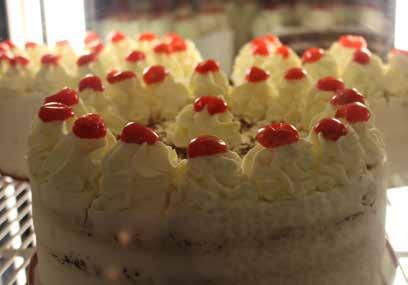
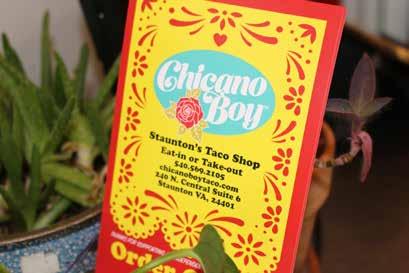
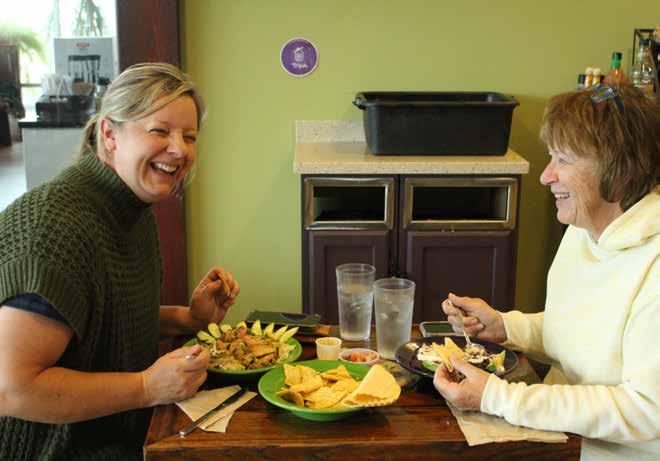 Top: Edelweiss’ signature dessert
Top: Edelweiss’ signature dessert

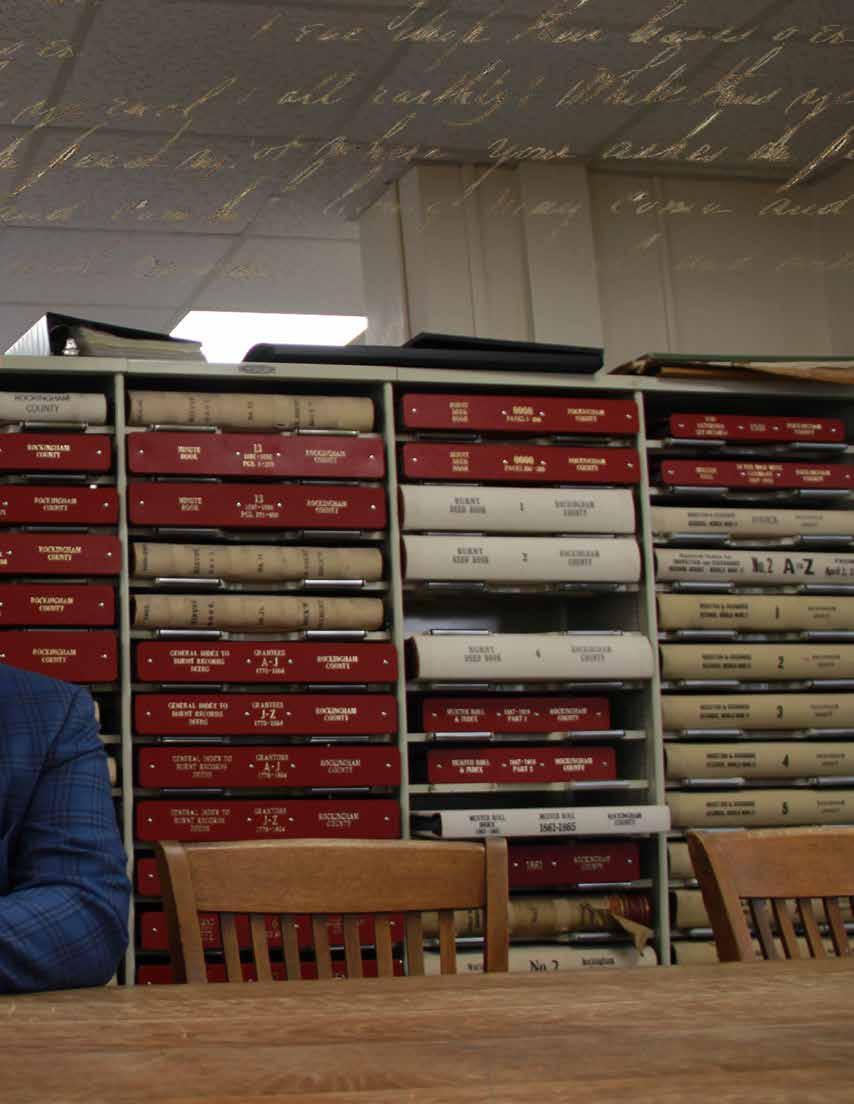
Rockingham County Circuit Court Clerk Chaz Haywood has made preserving local history a hallmark of his time in office
Haywood has been many things: a military man, a consultant in Washington D.C., a James Madison University student and even a cobbler to make ends meet. Now, he’s the Clerk of the Circuit Court in Rockingham County. But above all else, he’s a history buff.
Haywood sits in his office in the historic Court Square Courthouse, surrounded by artifacts of his own history. Genealogy charts spread across the walls, and black-and-white photos of his family are displayed proudly in a cabinet…his grandfather Charles’ photo front and center.
“I always thought I was going to be a history and sociology teacher like my grandfather,” Haywood said. “It didn’t work out that way.”
Haywood was elected clerk in 2008, and has since led the transformation of the Rockingham County historical archives. In the process, Haywood and his archival team have discovered a treasure trove of original historical documents going back to 1778, when Rockingham County was created.
Under Haywood’s leadership, the Court Square Courthouse found itself as the steward of Rockingham County’s history. Beyond just holding the physical archives, Haywood’s Courthouse has become a center for historical storytelling.
“It’s telling the stories of these case files,” Haywood said. “And that’s what we want to keep doing. So it’s not just keeping the record, but it’s saying, ‘Here it is,’ giving it to you. ‘Here’s a great story. This should be of interest.’” Haywood’s love for history and genealogy came from his grandfather
“Everybody loves a good story,” Haywood said. “And if you can connect with just a story, it’s going to have more impact and last longer. So that’s what I’m trying to do here with these stories. These cases and stuff that maybe people forgot about—let’s tell the story.”
Before Haywood’s term, boxes of records were stacked perilously to the ceiling in storage rooms and collected coal dust next to the old boiler in the basement. Miraculously, the dry coal-smoke conditions were good for preservation of the old, delicate paper. Haywood feels grateful that his courthouse has the resources to preserve and properly archive these historical case files.
“I think public historians, archivists, they need to be good story
”
Charles, who shared family histories with him as a child in Montana as a method of teaching his grandchild life lessons. He regrets not paying close enough attention to remember them now, decades later.
“I listened, because that’s what we do with our grandparents,” Haywood said. “But gosh darn it. Shame on me for not hearing more. And I get that, now that I have grandkids.”
Haywood remembers how his grandfather would say, “let me give you a little story,” before launching into a historical tale. Now, Haywood cultivates that same enthusiasm for sharing the stories his courthouse has discovered deep within the archives.
Before Haywood’s term, boxes of records were stacked perilously to the ceiling in storage rooms and collected coal dust next to the old boiler in the basement. Miraculously, the dry coal-smoke conditions were good for preservation of the old, delicate paper. Haywood feels grateful that his courthouse has the resources to preserve and properly archive these historical case files.
Last year, he was able to hire a full-time historical archivist, Megan Schoeman. She works at preserving and digitizing the historical record in Rockingham County. Schoeman’s fascination with local history comes from being raised in China as the child of a U.S. diplomat, searching for a connection with her home country through her interest in American history.
“I think public historians, archivists, they need to be good storytellers,” said Schoeman.
“Otherwise they’re just custodians. And so, what do you do with this information that you’re looking after and storing? You want people to be able to enjoy it too.”
Haywood describes finding records written on vellum—a historic material made out of thin sheets of animal hide–including land grants from King George II and King George II. That’s when Haywood and the archivists knew they had found a collection worth sharing.
“What I wanted to do is not just start keeping the record, but saving the record,” Haywood said. “Because as we started to go through room after room here, drawer after drawer,

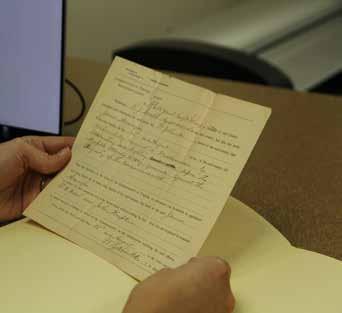

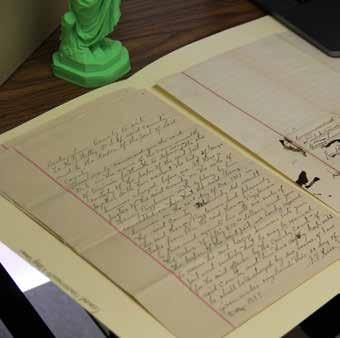
cabinet after cabinet. I mean, rooms were filled to the brink and then closed the door, throw a few more things on top, and that’s how it was.”
Some of Haywood’s favorite histories discovered in Rockingham County’s case files include a thwarted assassination plot on George Washington, the antics of secret moonshine distilleries in the mountains during Prohibition and the devastation that the construction of Skyline Drive wreaked on the local community. The courthouse features these stories and more in its column “Clerk’s Corner” in partnership with the Daily-News Record.
Any cases over 100 years old are being digitized with the goal of publishing to the public. Haywood and Schoeman are proud of the work they’ve been able to accomplish so far, but the sheer size of the record collection means there’s still a lot of preservation waiting to be done.
“Last year we hit 10.2 million images…” Haywood said, grinning. “Not too bad for a little circuit court clerk’s office.”
Haywood and Schoeman are happy to see that their collections in the archives are helping families learn their histories. Local histories in collections like “Histories Along the Blue Ridge” humanize the people who lived in the past, and allow previously forgotten stories to be rediscovered.
Haywood discovered his own family connections to Virginia through archival records—a seventh-great grandmother’s name was discovered on a marriage record in Rockingham County. Now, despite growing up in Montana, Haywood feels this historical revelation makes him a true Virginian. He’s excited that his courthouse can provide those tools of historical discovery to other people searching for their family histories in Rockingham County.
Haywood isn’t technically a historian, but somehow he finds himself immersed in the small details of history.

“I don’t know that much,” Haywood said. “I know a little bit about a lot of things, not a lot about a little things.”
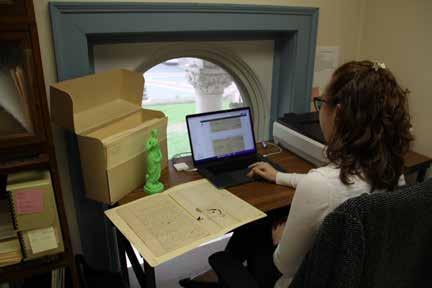 Top: An intern looks over documents. Middle: Haywood’s grandfather Charles. Bottom: Documents are stored in manilla folders to keep them safe. Bottom right: a JMU grad student works to help preserve records.
Top: An intern looks over documents. Middle: Haywood’s grandfather Charles. Bottom: Documents are stored in manilla folders to keep them safe. Bottom right: a JMU grad student works to help preserve records.

Raid your grandpa’s closet! Residents in the Valley are putting the Earth before their wallets before purchasing new clothing. Time to ask: How does your style impact the Earth?
Story and by Caroline Stoaks



estled between Rocktown Kitchen and Drifters Cafe in downtown Harrisonburg lies a small second-hand shop that has found favor in the eyes of sustainable shoppers. As you walk in, racks of vibrant vintage clothing flood the room with color. A towering wooden shelf filled with well-loved shoes rests against the wall.
Mary Yoder-Anderson, who started Dart in October 2020, founded the store to encourage sustainable buying in the community. “There is so much clothing out in the world, it’s easy enough for people to shop sustainably and buy second-hand,”
Yoder-Anderson said. “We have some great second-hand options in our community with vintage stores and buy-and-sell trade stores like Dart or Plato’s Closet, thrift stores or you can also buy online on Poshmark, eBay or Depop. “It’s a great way to keep clothing out of the landfill.”
Dart is part of a thrifting and second-hand shopping scene that has been popular among college students in the community. “I just love how young people are buying second-hand,”
Yoder-Anderson said. “It’s just the norm for people to thrift. When I was younger, that definitely wasn’t the trend, so I love that it’s more popular now and more common.”
The trend may be fueled in part by social media. Two JMU students, Hassan Ali and Bryce Kelso, who started a fashion Instagram account, @jmufits, have seen the growth, too.
Ali and Kelso photograph students’ eyecatching outfits and what has caught their eye most is the trend of more and more students buying second-hand fashion.
Kelso said in high school, his youth pastor promoted the importance of secondhand shopping. “There are unfair labor practices that occur in third world countries that people aren’t aware of, how clothes get mass produced and shipped across the world coming from poor working conditions,” he said. “Sustainable fashion is defi nitely something that I could at least apply to my personal consumption practices, and be a little more aware of where I’m buying from.”
Ali is an advocate of knowing where your money is going before you spend it. “A lot of research goes into what I buy. I know a lot of people are still blindsided about Shein and fast fashion places like American Eagle and H&M and how cheaply everything is made,” he said. “You should research what you’re buying before you pull out your credit card.”
By purchasing fast fashion, Ali said, “You’re giving money to corporations who are ultimately treating their workers wrong and it’s cheaply made clothing for double the price just to have people follow trends. I think that’s very abusive of these corporations.”
In the clothing design process, Downs said in practice you will fail and have to discard pieces, although instead of throwing away fabric, he encourages other designers to repurpose and upcycle fabrics and thrifted pieces.
Since the beginning of his fashion business, Downs has been promoting sustainable fashion.
“I’d resell vintage and go thrift. I had a page where I curated the thrift I would find that I thought other people would enjoy” Downs said.
In his most recent line, “Caught Up,” Downs hand sews a black sweatshirt and bleaches it to create a spider web design. He then hand stitches an outline in violet, scarlet and green around the spider web producing a chilling look.
Kelso agrees with Downs and encourages upcycling clothing. “I am a big proponent of repairing, reusing and recycling old clothes that you have,” he said. “I bought my sewing machine when I was a junior in high school and it’s been the best thing I’ve ever had.” In addition to upcycling, Downs said promoting fashion at a small business scale is how we can do our part to encourage sustainability. Downs is hosting Harrisonburg’s first-ever fashion show in September, called 540 Fashion Day Valley Vogue. Involving Downtown Harrisonburg, the show will feature resale and vintage shops such as Dart, Heartworn Vintage and fair trade shops including Green Hummingbird.
It’s a great way to
clothing out of the “
“Green Hummingbird is 100% Sustainable humanitarian-wise, as well as clothing-wise,” Downs said. “A big thing in fashion is sweatshops getting clothing manufactured from places that are not humane or they don’t pay their workers, so fair trade is getting clothing sourced from factories and craftsmen who are paid fairly for their work.”
Downs said it’s important to stay away from brands that contribute to fast fashion.

- Yoder-Anderson
In addition to shopping second-hand, another sustainable clothing consumption practice is clothing swaps. Ali and Kelso helped organize a clothing swap with radio station WXJM. Individuals brought worn clothing items to the event and the amount they brought in was the amount they could take out. Anything left over was donated to three Goodwill locations in the area.
Shenandoah Valley fashion designer Seth Downs offers a third solution, upcycling, for those passionate about making a difference in the environment and community.
“Fashion is a huge contributor to trash in landfills around the world and sustainability is important to me,” Downs said.
He said “Not buying from Shein and huge brands that you don’t necessarily don’t know where it’s coming from” is paramount, “because sadly, if you don’t know where something’s been manufactured, most likely they are not letting you know for a reason.”
“Be responsible with your dollar,” Downs said by doing research to know where your clothing is coming from and about the individuals that manufacture the clothing.
Downs recognizes it isn’t as common to be hyper-aware of the manufacturer, although one known designer his show will feature is local curator, Leo Pacheco from Puerto Rico. “He finds second-hand items and sells them as a means to further the life of that individual piece and give it a new home,” said Downs
Inspired by the 540 area, Downs is pulling from the fashion of the Shenandoah Valley and supporting local businesses. The show is scheduled for early September and will be located in downtown Harrisonburg.
Thrifting may be popular in the Valley because, according to those who follow local fashion trends, there’s an emphasis on casual wear.
Kelso describes Valley fashion as a “hipster granola kind of vibe.” He said “When I look at the people in the community, I can tell that they don’t care too much about their appearance, but it’s very well put together at the same time. They got beanies, mustaches, sweaters and carabiners.”
The casual style of the Valley easily inspires sustainability. Ali encourages consumers to also be mindful of their consumption habits in thrifting which can become “dangerous” as its popularity rapidly increases.

“The dangers of second-hand clothing is that if people thrift too much it’s taking away some of the clothing options for people who actually need it.”
Kelso also refrains from offering thrifting as the only sustainable solution. “Obviously at some point, if everyone’s thrifting there won’t be enough clothes around,” he said.
“Whenever I go, I limit myself,” Ali said. “I will see people leaving with a bag full of stuff but I will leave with one or two items. I don’t feel comfortable leaving with more than five items because I don’t feel like it’s right for me.”
Sustainable fashion is becoming more of a staple in the Shenandoah Valley and we are here for it. Shopping second-hand, fair trade and upcycling are great solutions to com-
bat fast fashion consumption. From a stylistic approach, the fashion pieces found through these methods tend to be more unique and one-of-a-kind. By dressing more sustainable you not only look better, but you will feel better about your consumption patterns knowing you took a small step to make a big difference. And who knows, maybe one day, you’ll even find yourself featured on @jmufits or walking in a Valley fashion show for your second-hand fashion finds.
As the fashion industry grows, fast fashion and the lack of sustainability is a problem that’s not going to get better unless people are making others aware, Downs said. “Anyone who is cutting out big corporations and promoting fashion at a small business scale is doing thei part in sustainability.”
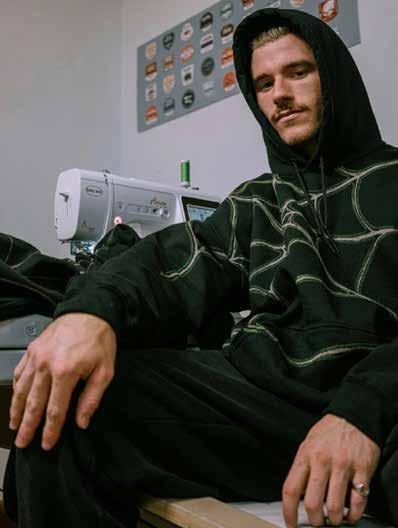
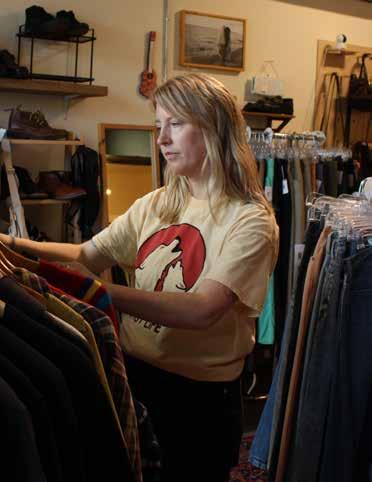
 Above: Seth Downs poses with his sewing machine.
Above: Seth Downs poses with his sewing machine.
Coffee and cats, what could be better? Local coffee shop puts a twist on how you could find you next furry friend
Story by Haden Raymer Photos by Annie McGowanAmanda Atwell has dreamed of opening a cat café for her entire life. For the longest time, she felt like they were a strange invention of her imagination until she stumbled across one in Toronto in 2017. Since then, she worked to make that dream come true in Harrisonburg.
If anyone was up for the task, it was Atwell. She has fostered cats since she was 16. She loves animals, with a dog, two cats and many fish at home. She became a classically trained chef 14 years ago and has a business degree.
But cat cafés are still a novel concept. They gained popularity in Japan in the 1990s, with the first one opening in the United States 10 years ago. Explaining the concept caused a lot of trouble for Atwell.
Many cat cafés have their cats freely roaming the establishment, with the emphasis more on cats than café. That did not fit Atwell’s vision because she wanted to establish separate spaces for the two areas.
She reached out to multiple foster organizations to partner with. “Most were skeptical,” Atwell said. But after laying out her vision for the Aristocat Café, the Humane Society of Shenandoah County was on board. The café now hosts fundraisers and events for the organization and, Atwell said, it has become the Humane Society’s “home base.”
Now that Atwell had her foster partner, she had to get the city on board. She laughs about it now, but she had serious doubts the city would approve her business. She says that while the city tried its best to understand the novelty of the concept, it caused a lot of issues. The city did not know what to define her as —. “So you’re a rescue? No. A pet store? No. So you’re a café? Yes!” —” she remembers them saying. “If only that did not take six months!”
The final struggle was finding the right location. Atwell went from place to place to find a willing landlord. The common reaction was, “You want to put how many cats in my space?”
When a space on North Liberty Street opened up, though, it was time to completely renovate. “Everything in here is new,” Atwell said. “We redid the plumbing, the wiring, we added the window here,” she said, pointing to the giant glass window that allows customers to look at the cats while enjoying their tea and coffee.
In all, the process that Atwell thought would take four months took almost a year. That extra time came with a silver lining. It allowed her to refine her business model, which helped lead to a successful opening.
It also gave her time to foster more relationships within the community. Atwell had faith in her tea but did not quite know how or what coffee to serve. “It’s Harrisonburg so we have to serve coffee,” she joked. Atwell eventually formed a partnership with Merge Coffee Company. She worked with them to create special blends for the Aristocat Café and they trained her and her employees how to use the machines and serve the coffee.
The level of success shocked Atwell. “I would have been happy with two adoptions a month, but we are seeing almost two a week,” she said. They have seen over 111 adoptions before their first anniversary in April. The café was nominated for multiple Best of the Valley awards sponsored by local media groups.
It also gave her time to foster more relationships within the community. Atwell had faith in her tea but did not quite know how or what coffee to serve. “It’s Harrisonburg so we have to serve coffee,” she joked. Atwell eventually formed a partnership with Merge Coffee Company. She worked with them to create special blends for the Aristocat Café and they trained her and her employees how to use the machines and serve the coffee.
The level of success shocked Atwell. “I would have been happy with two adoptions a month, but we are seeing almost two a week,” she said. They have seen over 111 adoptions before their first anniversary in April. The café was nominated for multiple Best of the Valley awards sponsored by local media groups.
In the future, Atwell just hopes the support continues. She loves hosting events, both for the community and for the Humane Society and hopes to host more in the coming months. Whether that is yoga nights, game nights, or a Dungeons and Dragons campaign, Atwell just wants to be more involved with the community.
She plans to increase the number of partnerships with local businesses, with one planned with neighboring restaurant Mashita. There is a plan with a local brewery to make a brew with her tea leaves. If the Aristocat Café continues to be the same community hub that it has become, Atwell will be more than happy.
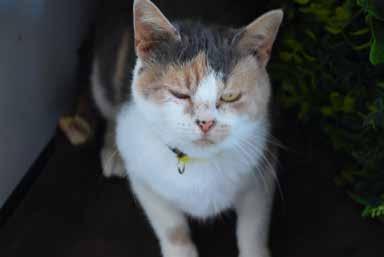
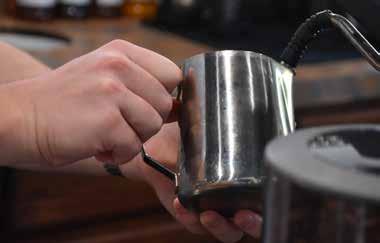
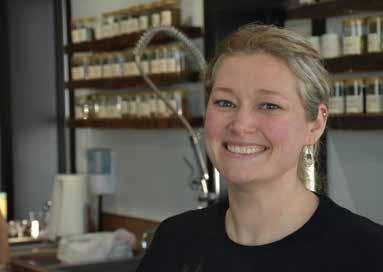
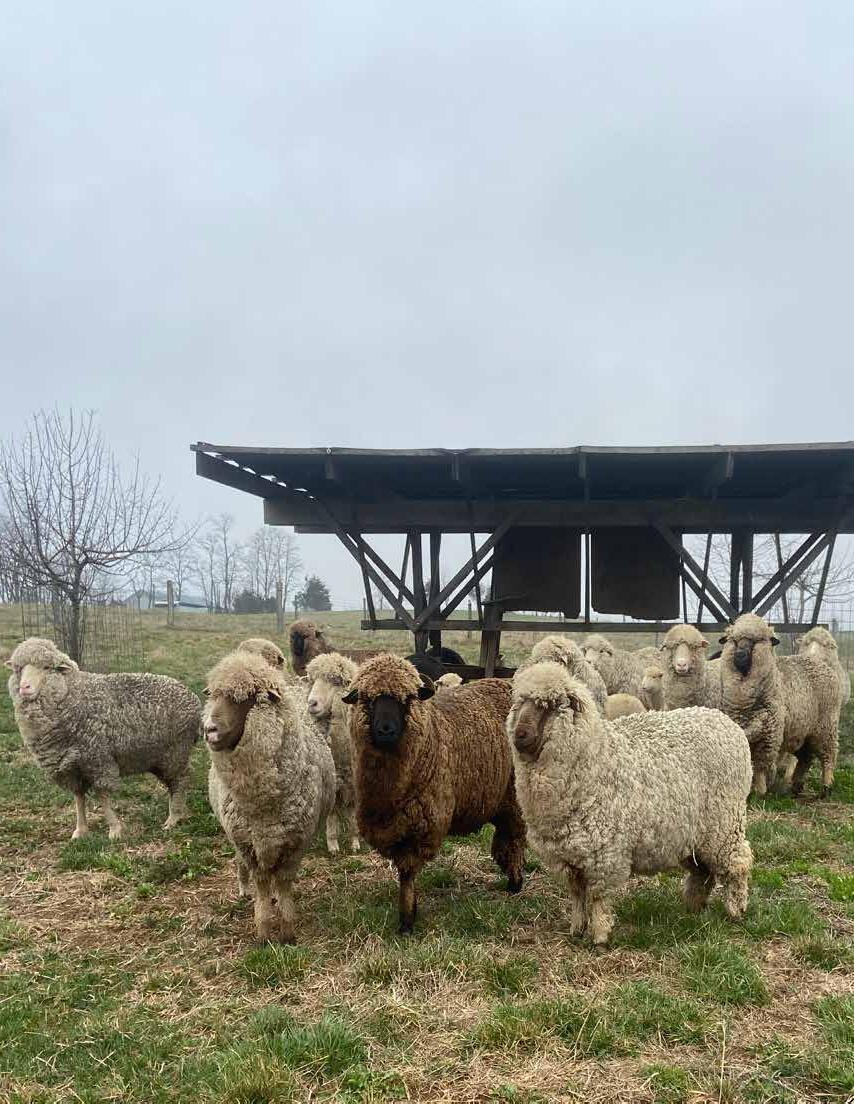
From fleece to fiber, Simple Hill Farms shows that it’s the simple things in life that allow for the farm and agriculture community to thrive.
Story and Photos by Maeve SummersHeidi Lantz-Trissel lives on an 11-acre farm off a winding road between Broadway and Harrisonburg with her husband, daughter and almost 50 other kids.
No, not those kinds of kids. Lantz-Trissel and her family raise dozens of sheep to create handmade yarn that is then sold to local and regional artisans.
Simple Hill Farm specializes in creating natural yarn from the sheep the family raises, embracing sustainable practices every step of the way. Lantz-Trissel, a former yarn-store owner and lifelong animal lover, found a special connection to the yarn-making process, and started work on her farm in 2008.
Lantz-Trissel had a flock of sheep on her farm that she cared for a couple years before she began the wool-making process.
“I always thought it’d be fun to have a farm and raise the wool from the start,” she said. “The farm has grown so much since then.”
Lantz-Trissel does most of the farm work herself, including the manual labor, the animal care and the yarn business. Though Lantz-Trissel said that her job looks a little bit different every day, one constant is how time-consuming making yarn can be.
The sheep get sheared once a year in the spring, and then the wool is sent to Green Mountain Spinnery in Vermont, where they wash and spin the wool into skeins. Lantz-Trissel receives the yarn back four to six months later, which she says is relatively quick compared to other farms that can take up to two years. Once the yarn returns to Harrisonburg, she dyes it using plants from her farm, and the yarn is washed and dried again.
“My goal is to raise as much of the materials as I can,” LantzTrissel said. “It’s nice to be able to be sustainable in that way instead of using dyes with chemicals.”
She’s off to a good start, as her garden contains several different plants that can create a variety of hues - madder root to make red, marigolds to make yellow and indigo flowers to make, well, indigo.
Dyeing with plants is just one way that Simple Hill has incorporated sustainability efforts into the work.
“It’s making it better than we started with,” Lantz-Trissel said. “And that goes for the animals, the plants, the grass, the dirt — everything.”
Every three to five days, Lantz-Trissel moves the sheep to a new spot in the pasture to allow grass to regrow. This strategy, she said, encourages deeper roots and helps with water runoff.
She also was able to connect with nature in a unique way and learn about some of the different ways that plants can be used.”
Though Lantz-Trissel hopes to increase community engagement in the future, she is happy with where the farm’s relationship with the public currently stands.
“There’s so many fun things about what we do here. It’s just nice to share that with the community - the support from anyone who’s come to visit the farm or purchased a skein from us means everything.”
Simple Hill also offers workshops, classes and children’s summer camps for community members to learn about different aspects of the yarn-making process, such as spinning, dyeing and weaving.
At Simple Hill, much of the farm labor is done manually in an effort to cut down on non-renewable resources. The farm doesn’t use chemicals, and instead of a tractor they use a sickle bar mower to cut grass. And although the yarn-dyeing process uses a lot of water, Lantz-Trissel collects rainwater in tanks to reuse for later.
The local community plays a key role in the success of the farm. After the yarn is dyed, washed and packaged, Lantz-Trissel sells her skeins locally at Rocktown Yarn as well as more broadly at fiber festivals all around the Mid-Atlantic.
“Our partnership with Simple Hill is something we really cherish,” Rocktown Yarn owner Amy Strunk said. “We love sourcing local fibers, and we get a lot of customers who appreciate small, local businesses as well.”
Every month, the farm has a Community Stitch Night, where people who knit or crochet can come together and work on their own yarn projects with those who have a similar hobby, as well as shop in the on-site store. “I want other people to be able to form a connection to animals and nature and fiber,” Lantz-Trissel said. “It’s an important connection to the earth and soil and what comes from that - the animals that grow, the fiber that comes from it - seeing that process is a lot of fun and can spark interest.”
Simple Hill also offers workshops, classes and children’s summer camps for community members to learn about different aspects of the yarn-making process, such as spinning, dyeing and weaving.
“[Simple Hill] was so good with my son,” a parent whose child attended the Fiber Farm Summer Camp said. “He came home every day talking about what he learned that day and what plants make what color dye. Of course he had fun, but he also was able to connect with nature in a unique way and learn about some of the different ways that plants can be used.”
Though Lantz-Trissel hopes to increase community engagement in the future, she is happy with where the farm’s relationship with the public currently stands.
“There’s so many fun things about what we do here. It’s just nice to share that with the community - the support from anyone who’s come to visit the farm or purchased a skein from us means everything.”

 Left: Sheep at Simple Hill Farm.
Top Right: Yarn created by Simple Hill.
Left: Sheep at Simple Hill Farm.
Top Right: Yarn created by Simple Hill.

Cynthia Sirk-Fear was in Harrisonburg when numerous fires broke out around and within Shenandoah National Park, just a few weeks before our interview. “It was really sudden that day,” Sirk-Fear said. “I was heading back to the park on 81 and I was seeing smoke everywhere and getting lots of phone calls.”
This was just another day in the life of a Shenandoah park ranger—where every corner of the 198,000 acres of wilderness—holds its own challenges. That week’s challenge happened to be a wildfire.
“It is so hard to think about what I do in a day. It really varies,” Sirk-Fear said. On the day of the interview, she was in the works of hiring a fire ecologist, and the following week she was scheduled to travel to Washington D.C. for training as a first responders yoga instructor.
Cynthia Sirk-Fear isn’t just a ranger; she is the Chief Ranger of Shenandoah National Park and one of the few women who hold that vital position. At age 47, she has worked with the park service for 25 years and she describes her becoming chief as “more of an accident than anything.”
Initially wanting to join the FBI, Sirk-Fear was inspired by a friend’s father to apply to the DC Park Police. There, she would work night shifts in Anacostia and witness fatalities almost every Friday on the BaltimoreWashington Parkway.
At that time, Sirk-Fear had four kids. “It was hard because he (the youngest child) was a baby and I was working midnights. We were like crossing paths,” Sirk-Fear said.
After 11 years as a DC Park Police, where she balanced a demanding career with raising her children, she eventually transitioned to a horsemounted ranger role at the Manassas Battlefield. She would be closer to her home in Haymarket Manassas and work fewer night shifts.
She realized his position combined her interests: ‘I was always interested in law enforcement and I loved being outdoors.”
It was in Manassas that her love for the unpredictable nature of being a ranger set in. “I like the fact that being a Park Ranger allows us to do all the things. I can go out and be on wildland fires for two days or I can go to a carry-out,” Sirk-Fear said.
After about a year in Manassas, she embarked on her chief ranger journey in Prince William Forest Park, spending a decade there before assuming her current role at Shenandoah, where she’s served for 15 years.
Beyond the traditional ranger duties of attending the Federal law enforcement training center in Georgia and completing field training, Shenandoah rangers have to meet even more requirements. All rangers have to be EMTs, wildlife firefighters and law enforcement officers due to the varying terrain. “There are a lot of parks that don’t require that,” Sirk-Fear said.
Many of the rangers are also skilled in technical rescue, which Sirk-Fear is not. “People forget that we have so many cliffs and waterfalls,” she said.
The park police’s Eagle helicopters have to perform about 6 hoists a year, where the rescue team is tasked with securing people’s bodies before they are lifted into the air. Other minor issues, consisting mostly of lower extremity injuries, require carry-outs where at least 12 people have to hike to the location and ‘carry out’ the injured person. For these issues, the park often relies on volunteers, using an online signup system called Eventbrite, to aid them.
Navigating through the park’s challenges also involves finding lost visitors. “People come here and they are so close to DC or you know civilization and they don’t think of it as wilderness,” Sirk-Fear said.“It is hard because if you have somebody that is lost you are like okay they could be anywhere,” Sirk-Fear said. “It’s like ‘Great there are 200,000 acres, now what?’”
Sirk-Fear recalled a story — a camper walked away from his campsite and got lost. It took two days before the missing person was finally found alive, which is “not usually what happens,” Sirk-Fear said. In these cases, rangers have to draw from as much information as possible about the missing person to narrow down an area and sometimes there’s just no information.
On a day-to-day basis, rangers get many calls. They consist of requests for a ranger to drive hikers back to their cars or reports of people illegally poaching a lucrative plant called Ginseng, which is native to Shenandoah.
“There are times when we get calls and we don’t have anyone available to do that right now,” Sirk-Fear said. “It is frustrating for some of the rangers because they feel like they should be able to get to every place in the park, but the reality is we can’t so you just have to prioritize.”
About three years ago, the call Sirk-Fear received was a serious one. A park intern was hiking on her day off when she saw something that did not look right along the trail. It was a plane crash. The wreck was next to a river not far off from the trail and it had been hiked by all day without any notice, a testament to the many mysteries that can be overlooked in the expanse of the wilderness.
Responding to the call with no hesitation, Sirk-Fear and a park supervisor were the first people to get there. They assessed that a carry-out of the male pilot’s body could not be achieved that day, and instead, two rangers had to spend the night with the pilot’s body, making sure no wild animals could get a hold of it.
“Some days you are just going to whatever the call is on the radio, which may not be the plan for the day, but I guess that is what makes it fun,” Sirk-Fear said.
For Sirk-Fear, it is clear that the thrill of the unknown is what drives her forward. When presented with the opportunity to teach a class called Fundamentals to new park employees over two months at the Grand Canyon, Sirk-Fear’s husband questioned her desire. This was because she typically dislikes being in front of people, however, her response was resolute: “Yeah that is why I am going to do it. It is going to be great.”
Some days you are just going to whatever the call is on the radio, which may not be the plan for the day, but I guess that is what makes it fun. “ “
Cynthia Sirk-Fear

Need a mid-day pick-me-up? Stroll across downtown Harrisonburg for one.
Story and Photos by Meagan Heitz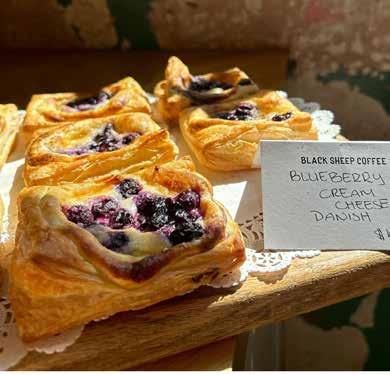
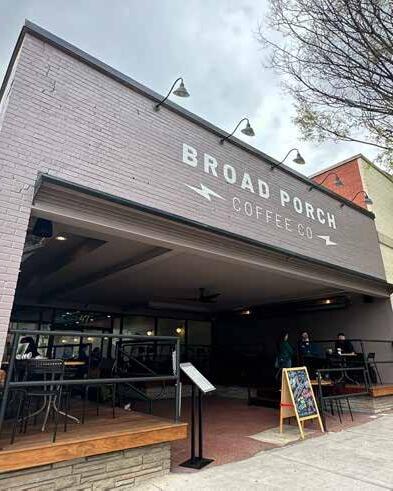
Any coffee shop in Harrisonburg —Broad Porch, Black Sheep and Coffee Hound — can be used as a workspace, hangout area or as a getaway for a “good cup of joe.”
“Coffee shops in Harrisonburg are everywhere, there are so many options that I would like to see before I graduate in May,” said Julianne Ulmer, a current senior at JMU.
Coffee Shops are known as prime places for students and residents to work there in their free time and hangout. Located downtown, these shops are just a small walk away from JMU’s campus and are considered “out of the norm” spots.
“Black Sheep has a nice area to sit in, it is more of an intimate environment, making it easy to talk to friends or work on assignments when campus is full and I want to get out of my apartment,” said Ulmer after visiting Black Sheep.
Due to the more intimate feeling, Black Sheep consists of a calmer environment that is smaller but full of character, located at the center of downtown, it can be easily accessible for parking and walking around.
“I would recommend this coffee shop if people are looking for a quieter and calm environment to sit and do work. I’m really able to focus when I am there and it’s really accessible downtown,” said Ulmer.
Broad Porch recently opened up a new location in Harrisonburg, giving more opportunities for those interested in hot-spots, but with time Broad Porch has become a big name in coffee.
“Whenever I’m in there I always see people that run into each other and just happen to be in the same spot studying or grabbing coffee. I think what makes it unique is the small-town atmosphere,” Jaeda Cohen said, a current senior at JMU known as a content creator.
The appeal of Broad Porch begins with the atmosphere they have at both locations, making it a revolving door for people to be productive and socialize.

“I would definitely recommend it, it’s a great spot to study, meet friends, take yourself on a date and more. I also love the lighting here and the aesthetic overall so makes it a great spot for content,” Cohen said
The Coffee Hound coffee shop, previously known as Shenandoah Joe’s, is known for its accessible parking, variety of different seating options and menu items for patrons who happen to find it.
“There are so many great coffee shops in Harrisonburg, but I really enjoy this coffee shop in particular for when I’m meeting up with a friend or when I’m studying because there’s a lot of space, a lot of light, fun seating choices, great coffee and it’s not a super loud place to be,” Ellie Lawrence, a current senior at JMU, said.
While the shop itself is known for its warm atmosphere and “calm and happy” environment, the shop is locally sourced, unlike other coffee chains, making it an easy recommendation.
“I would absolutely recommend it, the environment is very calm and happy—great natural lighting, fun colors, warm textures and plants. The coffee is phenomenal and locally sourced, which I love compared to chain stores,” said Lawrence.
Coffee shops in Harrisonburg include environments full of friendly atmospheres, good-quality food and a variety of coffee options for individuals looking to study, talk, or simply just sit with a coffee in-hand.
Top: Treats at Black Sheep
Bottom: Broad Porch’s facade on Court Square



In 1990, Jeff Wolter, a JMU senior at the time, opened a store called Party Perfect at the Kroger Shopping Center. Today that party supply store has expanded its scope and is prominently located near JMU on Port Republic Road.
It’s now called University Outpost.
Wolter’s sister Christine Johnson, had just just graduated from JMU that same year. The siblings became business partners of the store until Johnson decided to part ways in 2018.
“You know that’s family dynamics and everything changes when that happens,” Wolter said. “We’re happier now than when we were together because things were changing.”
Wolter grew up in Northern Virginia before he became a JMU student. However, he has never looked back since he graduated in 1991 and is still settled in Harrisonburg with a family of his own.
Wolter was a computer information system major in the College of Business when he opened Party Perfect. Wolter says aspirations of being an entrepreneur have always run in his family.
“We are always looking for ways to perfect other people’s businesses because we don’t think they run them very well,” Wolter said.
Party Perfect sold party supplies and products for Greek organizations. The store eventually moved to Warsaw Avenue into a building that no longer exists. After changing the location from the shopping center, the store was renamed to University Outpost, and the owners expanded to sell Greek and JMU-themed apparel and products.
Upon the start of their business, Wolter knew the store would face financial challenges. He was in his last year of college when the store first opened. After graduation he went into the banking field full time while also working part time at the store. Now, after 34 years, Wolter says he did not anticipate it to be as successful as it has become.
Around 1997, the Outpost moved to its current location on Port Republic Road. At that time Wolter added textbooks into the mix until 2019, a decision that kept the business afloat during financial challenges.
“You had to take some pains and we took those pains for quite some time,” Wolter said. “Then finally we just ended up getting into the books, which helped bring us to where we are today.”
In 2008, Wolter parted ways with Greek organizations due to some differences over how to share profits with the organizations.
According to Wolter, the demand for textbooks slowly started to disappear in 2011 . Therefore, he realized that the business was not going to make the money they used to through textbooks and it was not going to be enough to keep the business alive.
“You have to stay dynamic in this world because if you don’t you will become dead,” Wolter said.
Textbooks were a significant factor because many people did not care to purchase JMU merchandise until 2004 when the JMU football team won its first football national championship. That year, Outpost made a profit of $30,000 to $40,000 just from the championship sales. In 2016, when the team won the national championship again, it only took the store an hour online to reach 2004’s profit in championship sales.
During the time Outpost sold and rented textbooks to students, the campus bookstore was the business’s primary competition in terms of who bought the most books and who had the most used books available. However, with time it all kind of mended together and both businesses now operate separately without clashing with one another.
Wolter says it is important for the Outpost to differentiate itself from others that sell JMU merchandise, like the JMU Bookstore and Walmart. Due to his knowledge of where those stores order from, Wolter is able to avoid ordering anything from the same place to make sure the designs he sells are unique. He says he also asks his employees, a group of mostly JMU students, their opinions to keep up with new or resurfacing trends.
Isabella Antoon, a JMU senior, enjoys shopping at the Outpost because of the variety the store offers with a cheap and resealable price. She visits the store occasionally, but will always go before a football game for the free buttons the store provides.
The owners of the one-stop shop for all things JMU tell the story of how they got started
Storyby PJ Barua
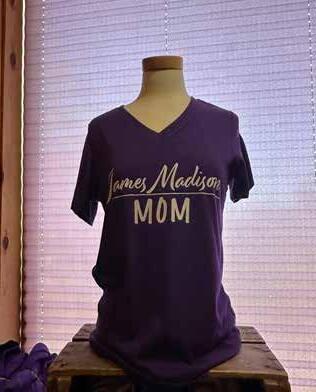
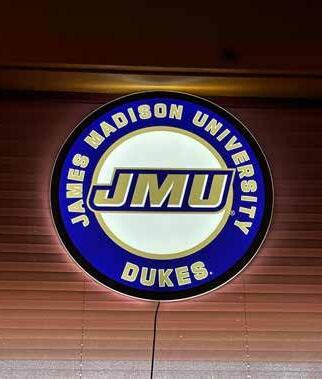
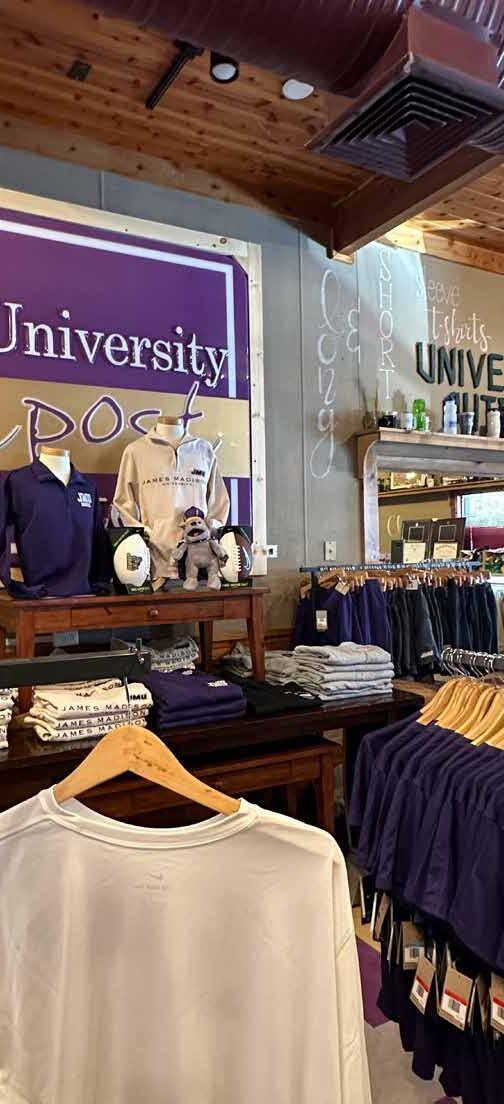
You have to stay dynamic in this world because if you dont you will become dead “ “- Jeff Wolter
“They are always coming out with new stuff but also have the usual stuff, like alumni sweatshirts,” Antton said. “I will definitely go to the Outpost to get my JMU alumni sweatshirt because I know it is the cheapest option.”
Antoon adds that as a JMU tour guide, she typically recommends families pay a visit to the University Outpost.
During JMU events like tours, parents of incoming freshmen frequent the Outpost. Brande Heitz, mother of a JMU senior, said she first went into the store when she came for her daughter’s orientation.
“The store was clean, organized and we could easily find what we were looking for,” Heitz said.
Now Heitz visits the store during times like family weekend or when they have picked up her daughter at the end of the semester.
The Outposts’s success continued as Wolter opened a second location in Harrisonburg Downtown around August of 2022. That decision came to be when the business went through a stagnant period. According to him, if you don’t keep your eyes open and keep moving along, your business will stay the same and falter.
Although the Outpost started out as a family business, Wolter says he would only continue to keep it in the family if his kids choose to take over. However, both his daughters are currently involved with the Outpost located downtown.
He adds how the business has relaxed over the years, yet they will still have days like College GameDay when the lines are long, getting in and out of the parking lot is hectic and just a workday more chaotic than usual.
Nevertheless, days like that are not new to Wolter.
“We’ve been doing it for years,” Wolter said. “We love the challenge and we want more challenges.”
The innovation of student affairs through theater, Jonathan Stewart lives a bit of a double life
Story and Photos by Elise Hellmann
When Jonathan Stewart is not in his office at JMU, he is probably writing music, volunteering for Court Square Theater or particpating in an improv show.
Stewart is the Director for Finance, IT, and Assessment for the division of Student Affairs. He makes sure JMU has good processes in place, supervises the Student Affairs Technical Service team and deals with a handful of budgets.
He is considered “a unicorn in student affairs,” because having expertise in these three areas is rare and “not a job that usually opens up,” Executive Advisor to the Vice President of Student Affairs, Carson Lonett said. “He is probably seen as one of our most strategic team members.”
Before Stewart held this position, he worked as an Administration Specialist and Fiscal Technician in the JMU theater and dance program. His experience as a theater and performance major for his undergraduate degree and his master’s in business made him a perfect fit.
Stewart’s current student affairs job does not include his love for the arts in a way that his position in the theater and dance position did, however, it is reflected in what he does in his private life.
“I do feel like I live dual lives at times,” he said. “I’m a sort of behind-thescenes administrator in student affairs, but I’m often on the stage and out in public in my private life.”
His participation in an improvisation group called Rocktown Improv is his main hobby outside of work. One of the other group members, John Huffman, also works with him at JMU in connecting offices as an IT Consultant for Student Affairs.
“He’s a great performer, with good intuition,” Huffman said. This intuition also translates into their work life: “He knows when I need to get out of the office, he’ll say ‘I know you need to go on a walk right now’ and I do.”
When Huffman and Stewart perform improvisation together, they are comfortable with one another. “You give gifts to your scene partner and those gifts are details and characters and their things to work with and that’s why I think we work so well, he is always giving those things,” Huffman said.
Stewart’s improv skills are often needed in his job in student affairs.
He taught a workshop, as a part of his student affairs position, to biology students who needed help with their thesis. He made them visualize themselves as crabs presenting their thesis to their grandma.
“If you can be a crab teaching your grandma, who knows anything about your topic, you can stand in front of your class and tell them about your work,” Stewart said.
Letting people “get silly” is important to Stewart, because it allows people’s brains to switch up in different ways. “There are certain improv things, like when you are brainstorming, that you can bring in, like empathy mapping,” Stewart said.
Maybe further explain what “empathy mapping” is - a common question the reader may have.
The improv technique of asking “yes, and” is something he tries to put into all aspects of his life. Improvisation “requires listening and responding, and that makes me a better supervisor and employee,” Stewart said.
“One thing I would call Jonathan is a change maker. He is the one who is willing to ask the hard questions and with that, he is very people-centered,” Lonett said. “You could take anything he does in his improv show and relate it to how he interacts in our world; He is willing to make things happen.”

Need an outdoor activity for the season? Don’t go too far, there is so much to do here in the Valley!
Story and Photos by Virginia Brooks
As temperatures begin to rise, many enjoy hiking and spending time outside. Camping at Shenandoah National Park is an affordable and great way to stay immersed in nature while being close to many other activities in the Valley. Big Meadows (insert hyperlink) campground is centrally located in the SNP and close to many hikes ranging in difficulty from Bearfence Mountain Trail, a quick mile loop, to Old Rag Mountain, a more difficult 9-mile loop perfect for a day trip.
Big Meadows is a campground offering many campsites and amenities. It is closed until the beginning of the spring and is available to both tent and RV campers. It is recommended to bring a tent, sleeping bags, flashlights, and plenty of food, but watch out for bears.

The Shenandoah Valley is home to many of the most scenic views in Virginia. Each fall, these views are en hanced by the landscape mosaic of beautiful fall leaves, intertwining hues of amber, crimson and gold.
According to the Virginia Department of Forestry, leaves roughly tend to peak in boldness of color between Oct. 10-31. It is during this short time period where visitors flock to Skyline Drive, Massanutten Resort or one of the many scenic overlooks in the area to catch the perfect glimpses of the foliage.
Massanutten Resort provides scenic chairlift rides seasonally, which is an alternative way to enjoy the beautiful landscape. Aubrey Grubbs, senior at JMU, took advantage of the chairlift at the end of October, the month of peak foliage.

“The perspective from above offers a whole new appreciation for the beauty of fall leaves,” Grubbs said. Grubbs described the experience as something she




Summer in the Valley means temperatures averaging in the high 80s. Taking advantage of the many rivers and creeks that run through the Valley is a scenic and affordable way to cool off. There are many places to take a plunge such as the falls in St Mary’s Wilderness and Blue Hole.
There are also many companies that offer tubing trips down the river. This is a relaxing way to cool off and spend a day. Shenandoah River Outfitters offer what they consider to be “the best tubing trips” in the Valley. They offer many start times for a 3-mile relaxing tube down the river.

Paired hand in hand with the unpredictable Virginia weather comes a chilling winter for the Valley with low temperatures and strong winds. Some outdoor enthusiasts continue hiking and mountain biking, however, snow sports are the most seasonal choice.

The Shenandoah Valley typically receives on average 19-24 inches of snow per year.
While not as ideal as mountains out west, many residents and visitors return each year to one of the many resorts — Bryce, Massenutten and Wintergreen Resorts — in the Valley to participate in a variety of winter sports.
While skiing and snowboarding are the most commonly thought of snow sports, snow tubing is another option of an outdoor activity that is accessible to most. Snow tubing is riding an inflatable tube down a hill, much less steep than a typical skiing or snowboarding hill. Tubing is avail able typically from mid December to early March.


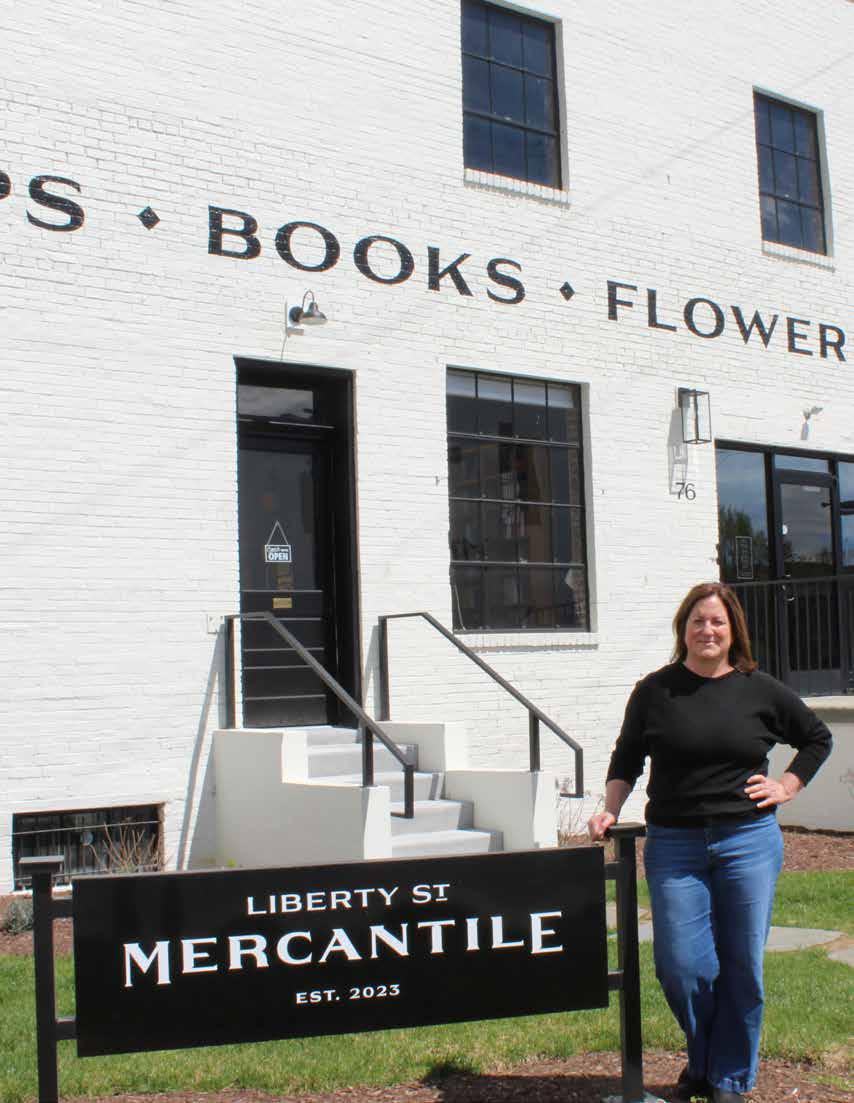
Kirsten Moore proudly surveys the century-old beams in the Liberty St. Mercantile’s event space. After years of tricky renovations on the late-1800s building and a $2.5 million investment, Liberty St. Mercantile is open for business.
“With Magpie,” she says, referring to the diner across the street that she founded, “when I walked in there the very first time I just had like this sort of picture flash in my head of what I wanted it to look like…this one was a little bit more a sort of work in progress.”
The old general store’s crisp white-and-black exterior and industrial-chic aesthetics at Liberty St. Mercantile mirror Magpie Diner. When the building that now contains the Mercantile went up for sale as a historic renovation project, Moore remembers feeling concerned a new developer could “mess up the vibe” of the little corner district on West Gay Street that she’s helped transform. Once she walked inside, Moore says, she knew the building could be something “cool.”
In 2020, a new cluster of trendy businesses around West Gay Street changed the atmosphere of the northern warehouse district, previously the home of mostly industrial warehouses and auto body shops. Now, you can still buy a tire, but you may have to fight for parking.
Informally known as the “Bird District” due to the bird names at many establishments—Magpie Diner, the Perch, Sage Bird Ciderworks—Harrisonburg’s Downtown district is stretching north of its old confines.
Moore, who previously worked as a food writer and a graphic designer, is one of a growing group of entrepreneurs setting up shop in the north end of downtown. A Harrisonburg native, Moore always meant to move out of her hometown. Instead, she decided to help make it a “little bit cooler to live in.”
“I don’t know what made me stay,” Moore says. “You know, I settled down, got married, had kids. And then, you just kind of get into life and you forget to forget that you were going to go someplace else. It’s a great place to raise a family.”
Moore started out doing graphic design and publicrelations work for a local architecture firm. The firm wanted a co-working space built above its offices, and Moore took over the design and execution of that challenge. It was such a success that she then worked with the same investors to open Magpie Diner, her “Hopper-inspired” breakfast spot with a co-working space above, created in a renovated car garage.
Moore’s emphasis on aesthetics and design is a driving motivator. After Magpie opened on the corner of West Gay and North Liberty streets, nestled behind a tire garage and an old warehouse, Moore began eyeing the building across the street after it went on the market. Moore says there were some “dumb” ideas from other developers for what the space could become, but her imagination was sparked.
“I was never looking to do any of it, I was just happy doing my thing…it’s mostly just opportunity,” Moore says. “I feel like I have creative ideas, and [I’m] happy to take a risk.”
That risk turned into Liberty St. Mercantile, a collection of small shops, boutiques and an event space in a renovated late-1800s general store building. With the Mercantile and her other businesses, Moore feels like she’s helped “bring back life” to the north end of Harrisonburg and filled a needed niche for the Harrisonburg community. The amount of traffic on West Gay Street surprised her, and she feels like she discovered an “underutilized space.”
“What we’ve done here is good and has done good things for the community,” Moore says. “We’ve saved two old buildings from being torn down and something else put in their place. So by doing that, we’re revitalizing an area of town that needed some love.”
Moore says she struggles with knowing that the city is assessing taxes at a higher rate now in the area of her projects. People who live on Collicello Street have higher property taxes, and nearby rental properties are raising their rents. She feels it’s unfair to point to Magpie Diner and the new development as the cause of that, but worries about walking the “fine line” between revitalization and gentrification.


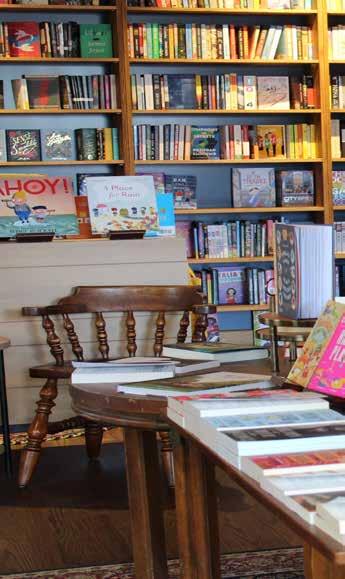
“At what point does that lean on the gentrification side, where it makes it impossible for people to, you know, be in the space that you created?” Moore asks herself.
Barry Kelley, chief executive officer of Matcbox Realty, has watched as Harrisonburg’s Downtown has shifted from a ghost town in the 1980s to the expansion and creativity of the last decade. Matchbox Realty developed the City Exchange apartment building in 2004, when it was nothing but a historic old warehouse amongst others of its kind.
At the time, Kelley says that Matchbox was surprised at the demand to live in the then-new building. Now, the City Exchange neighbors Liberty St. Mercantile across the train tracks on West Gay Street and enjoys its proximity to the shops, coffee shops and nightlife that have emerged.
Kelley says property taxes in the area are increasing to a rate that is “not sustainable.” Matchbox Reality has seen 40 to 50% property tax spikes in the last two years, and Kelley fears more increases are coming. He worries about the rising costs of insurance, maintenance, renovation labor and appliances for Matchbox properties.
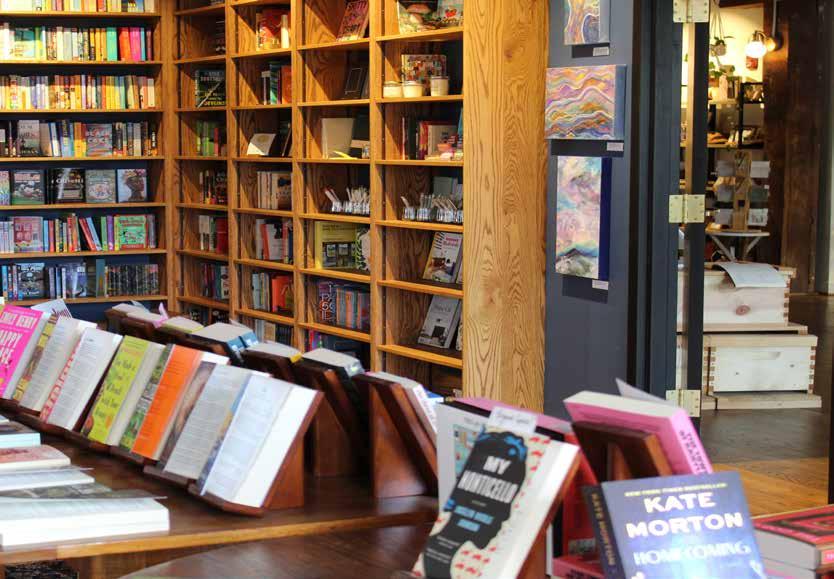
Kelley is also concerned about the lack of transparency when it comes to Harrisonburg’s increased property tax in popular new areas like the north end of downtown—and the resulting higher cost of living for the community.
“[The city of Harrisonburg] is not really doing this mathematically,” Kelley said. “It’s more like, ‘Oh, I think this is worth that.’ And so [they] put the number on it.”
As the north end grows more popular, Moore is excited to see other creative business ventures pop up around Magpie and the Mercantile.
Sage Bird Ciderworks opened in September 2020, just a few months after its neighbor Magpie Diner’s doors opened.
Situated in an old car garage and warehouse, Sage Bird Ciderworks created a colorful, mural-filled space with industrial-chic elements similar to establishments in the Scott’s Addition district of Richmond.
When founder and co-owner Zach Carlson and his wife Amberlee signed the lease on the building in 2019, the collection of warehouse buildings around West Gay Street were “non-operational.” Carlson’s decision to open Sage Bird Ciderworks on the north end of downtown came down to the fact it was a rare available space close to downtown’s center, and it was big enough for their brewing operation.
“It’s been an interesting kind of push northward for downtown and it seems to kind of make sense…with some of the revitalization efforts and just the way that people have developed a new interest in downtown,” Carlson said. “There’s only
so much space really, you know, and downtown is pretty full.”
He believes that the “North End” or “Bird District” is “bridging the gap” between the end of Historic Downtown and beloved spaces like The Little Grill and Chop House restaurants. Carlson says Sage Bird Ciderworks has worked to embrace the community in the north end of downtown, and they’ve been welcomed in turn.
“Harrisonburg is not a particularly cool, trendy place on its own,” Carlson said. “And so, you know, if we want Harrisonburg to be cultural and to be important, to have cool things going on, we’ve got to work together to make it happen.”
Carl Strite, owner of Strite’s Donuts, rents a spot a few doors down from Magpie and the Mercantile. He’s noticed a huge influx of foot traffic and says that he wonders where everyone is coming from, but his mobile donut shop enjoys the increased business. His daughter is set to open a brick-andmortar Strite’s Donuts location in Harrisonburg even further north in the next four to six months.
“Harrisonburg’s really growing and it’s expanding in different areas and…in many ways,” Strite says. “I think it’s a really actively growing town at the moment. I like it.”
Concerns about the walkability of the West Gay Street and Liberty Street area mean that new parking and pedestrianfriendly infrastructure may be needed to fill the gap in the north end, and Strite says he hopes that new infrastructure is on its way soon.
The city has plans for Liberty Street, says Andrea Dono, executive director of Harrisonburg Downtown Renaissance. A recent survey of the community signaled interest in making the north end of downtown more visually-cohesive with the center. To help with that, HDR plans to install new street lights with banners that match the more-decorative street lights downtown.
“If you’re on Court Square and you just end up on Liberty Street and you look to your left and your right, you know, to the left you see a jail,” Dono said. “And then to the right…it’s not as compact and dense as Main Street is, and so it can be a little bit difficult for people to realize that there’s stuff there.”
Dono is excited to realize the community’s “vision for Liberty Street,” and says streetscaping will start in 2027 to widen sidewalks for pedestrians, install a bike lane and slow down car traffic in the area. This work is funded by a $14.3 million grant from the Rebuilding America, American Infrastructure with Sustainability and Equity Act. Dono says she’s hopeful that with additional funding, the city may be able to bury the utility lines that currently stretch overhead in the north end. These improvements will help give “visual cues” that pedestrians should explore.
HDR is celebrating 20 years of investment in Harrisonburg’s Historic Downtown—a district that has always included the north end, Dono says. In 2004, HDR hoped to save Harrisonburg from decades of “disinvestment” and abandoned historic buildings in the city’s center. The now-bustling downtown represents HDR’s success guiding local businesses back into the city’s historic center.
Despite the new activity happening around her, Moore says she’s not looking to start any new projects soon—she’s tired of renovations. Instead, Moore says she is ready to slow down and celebrate four years of Magpie Diner.
“I’m ready to be done with construction projects for a little while,” Moore says. “But I always have my eye on something else, and have already thought of something for a couple different properties that would be fun to do. But I’m not in any hurry.”
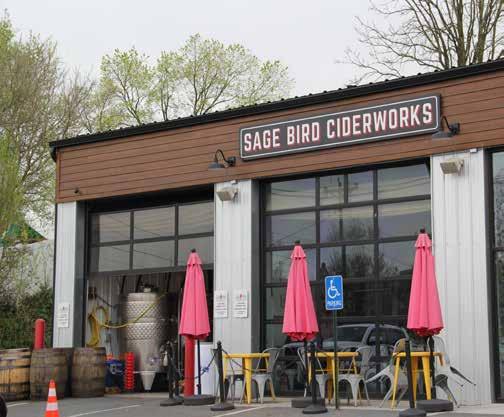

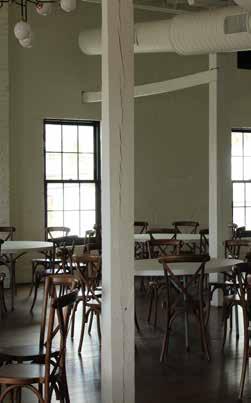
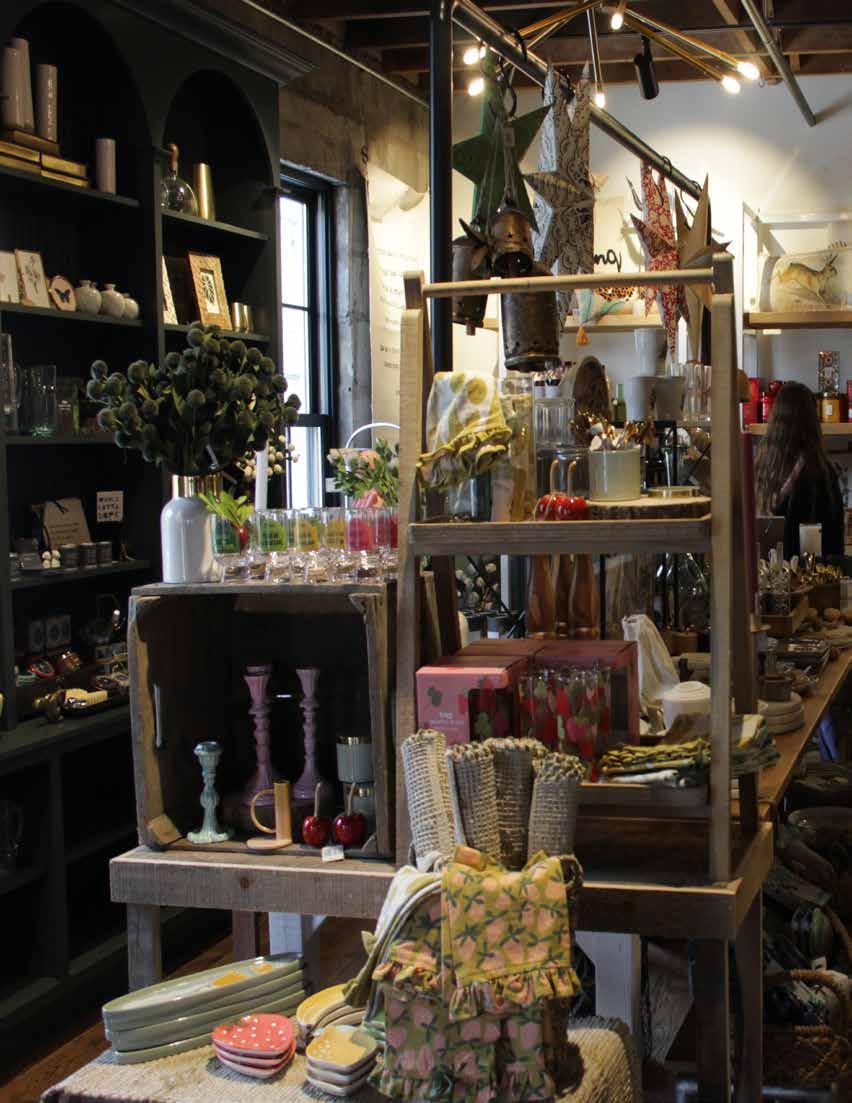
Whats Inside?
Inside the Mercantile, many shops offer gifts and goods. The shops include Parentheses Books, Living Room Collective, Asdelia Mae Boutique, Rocktown Yarn, Chestnut Ridge Coffee, Blackmore’s Flowers, Rootstock Wine Bar, as well as a rotating boutique kiosks and a large loft event space.

Harmony Havest Farm wants to shake up the floral industry, and grow some beautiful blooms, of course
Story and Photos by Annie McGowan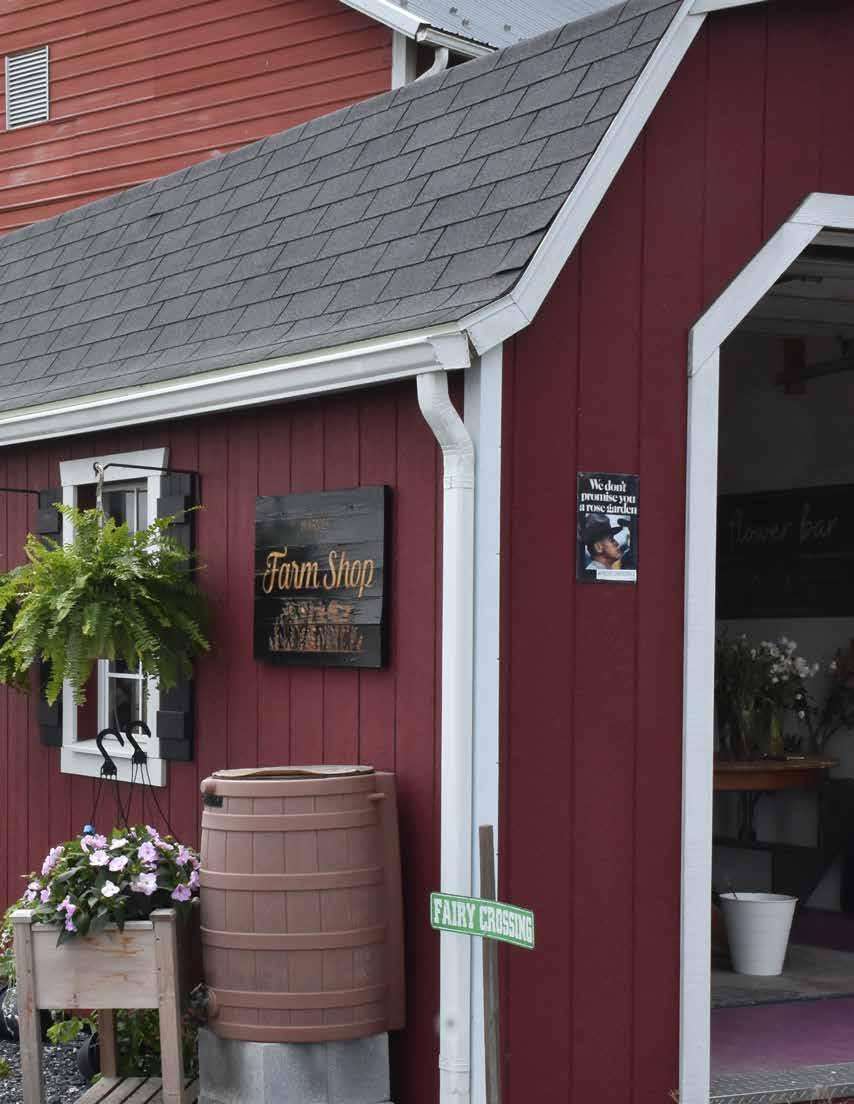
Down a gravel path in Weyers Cave, Virginia, Harmony Harvest Farm sits atop a hill. Surrounded by the lush green rolling hills of the Valley, this farm does not have any animals or fields of grain - instead there are six large greenhouses with rows and rows of flowers.
“Agriculture is more than plows, sows and cows,” joked cofounder Stephanie Duncan, “and it is amazing what you can do with just an acre of land.”
Overflowing with an infectious positive personality, with rainbow tie dye pants and a handmade flower crown, Duncan recalled how the farm got its start.
“We have always been involved in Agriculture,” Duncan said. “My father was an Agriculture teacher at the high school, and both my sister and I were involved in FFA (Future Farmers of America).”
Duncan’s sister, Jessica Hall, started Harmony Harvest when she bought the farm in 2011 alongside her mother Christine Auville, nicknamed The Lady Monarch, and soon relocated her family to the property. Hall studied horticulture at Virginia Tech, and thought that she would grow vegetables and produce on the property - until Auville suggested something different: flowers.
Duncan later joined the operation in 2013, and had a background in marketing and e-commerce, moving from Charlotte, NC back to the valley.
“I just did not want to work for anyone else anymore, but also I wanted to gaze at the mountains,” joked Duncan.
With the three of them utilizing their skills, Harmony Harvest began to blossom.
“Flower farming is unique, because it is the most agriculturally diverse field,” said Duncan, “I mean most of these farms are owned and run by women. It totally disrupts the idea of what a farmer is, which in most people’s mind is an old white man. It can be a boys club.”
Nowadays, most farmers are aging out, leaving large swatches of land open - hoping that a family member may take over the farm, which may not be the case for a lot of farmers reaching retirement age. Farmland is being lost because instead of it being kept in the family or sold - it is being sold to developers.
“With flower farming,” said Duncan, “you do not need much land to achieve what you need. Less land means less money spent on it, so it is very accessible to those who cannot buy acres and acres of land.”
Flower farming is still labor intensive, machines cannot cut the crops - instead each flower is planted and cut individually.
Annalise Hall, Jessica Hall’s daughter, sat in the greenhouse - listening to music through her headphones and helping plant seedlings.
“It is therapeutic,” Hall said, “you get into a rhythm.”
Truly a family-run and -operated a farm, visiting families scattered the greenhouses, picking colorful bouquets and chasing their children who ran barefoot up and down the rows. In the nearby farm shop, bouquets were carefully arranged, with bright florals and greenery draped over their vases and butcher paper wrappings awaiting a bunch of flowers. A bus-turned-food-truck hummed outside, connected to a generator. Picturesque in every sense, but things haven’t been a field of daisies for Harmony Harvest.
“During COVID-19 things got a little scary,” Duncan said. “We had been selling wholesale flowers to event coordinators, for weddings and events and such, as well as WholeFoods, but with the pandemic, we just had nowhere to sell our flowers.”


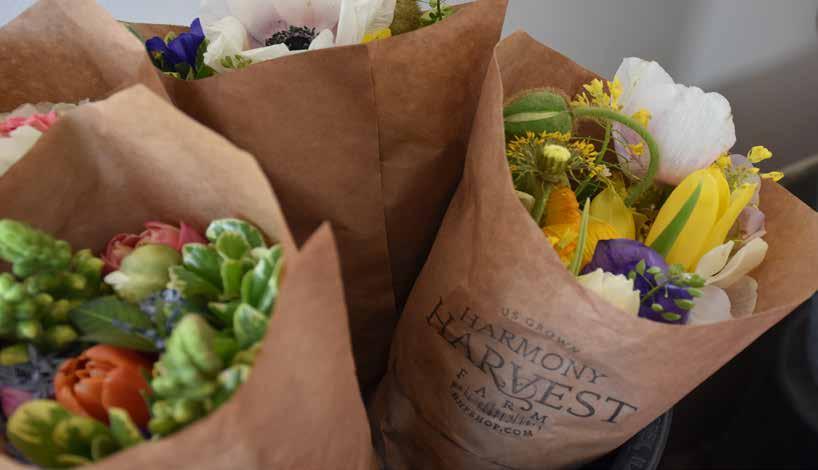
The global pandemic took out many small businesses during its height, but Harmony Harvest pivoted to something they did not expect.
“We started out wholesale only, right?” Duncan said, “but we had a few people call us and say, ‘Hey I know you don’t do this, but I forgot my mom’s birthday. Can you send a bouquet?’ And we did, and we kept getting calls like that. And eventually we said, ‘Hey! Let’s start selling bouquets online!’ ”
Surviving the pandemic, Harmony Harvest continues to grow, and its founders also started new projects.
“We began to sell heritage mums in 2021,” Duncan said. “They are a special type of chrysanthemum that can grow beautifully in the United States. These are not the mums that you see during the fall on people’s front porch, but a cut-style flower.”
Large and in-charge, these heritage mum’s are vibrant and are reminiscent of a dalia than the mums that most are used too. Easy to ship and easy to grow, these flowers have become the focus of Harmony Harvest - especially after they opened the farm to the public in July of 2022.
These mums also inspired the farm to launch what they called the Mum Project, an initiative to grow more flowers locally.
“80% of the flowers in the United
States are imported,” said Duncan, “which is crazy when you know that the cut flower industry is worth around 9 billion dollars. We want to inspire more farmers to grow flowers, and people to buy locally. Global trade is needed in our economy, take roses for example, they grow fantastic in Ecuador, but there are so many flowers that can be grown here in the United States that could give back to agricultural workers in the United States.”
Passionate about reshaping the flower industry, the girl gang that is Harmony Harvest wants to tap into locally-grown, high-quality flowers, and inspire people to ask where their flowers come from.
“There is an ethical piece to it,” Duncan said. “In the U.S. we have the EPA and labor laws, and if there is such a demand for flowers that come from outside of the U.S, there is probably a labor violation happening, as well as the environmental impact of transporting those flowers.”
Hoping to reshape the industry, Harmony Harvest is hoping to give the public beautiful flowers, but also help agricultural workers in the U.S. tap into a lucrative, sustainable market.
“I just want people to stay curious.” Duncan said. “Knowing where your flowers came from, or who they came from, is cool!”


“Flower
farming is unique, because it is the most agriculturally diverse field,” said Harmony Harvest Farm co-founder Stephanie Duncan. “I mean most of these farms are owned and run by women. It totally disrupts the idea of what a farmer is.”